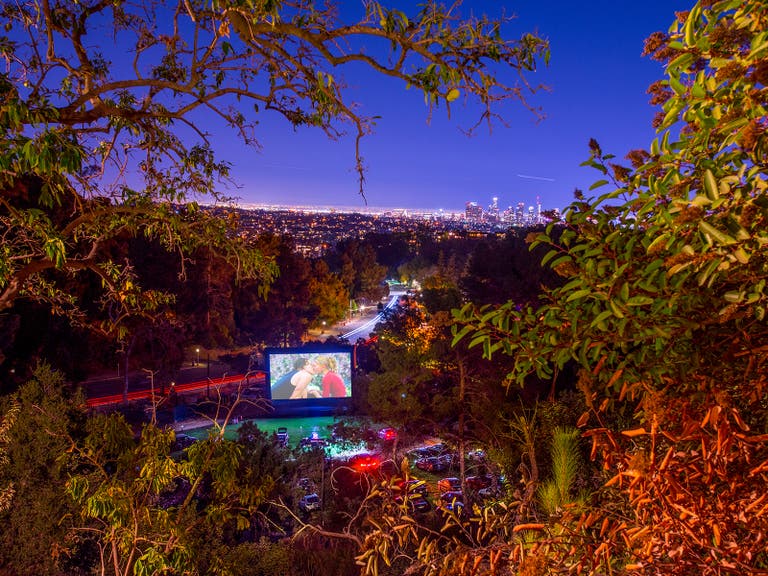"Pop for the People: Roy Lichtenstein in L.A." at Skirball Cultural Center
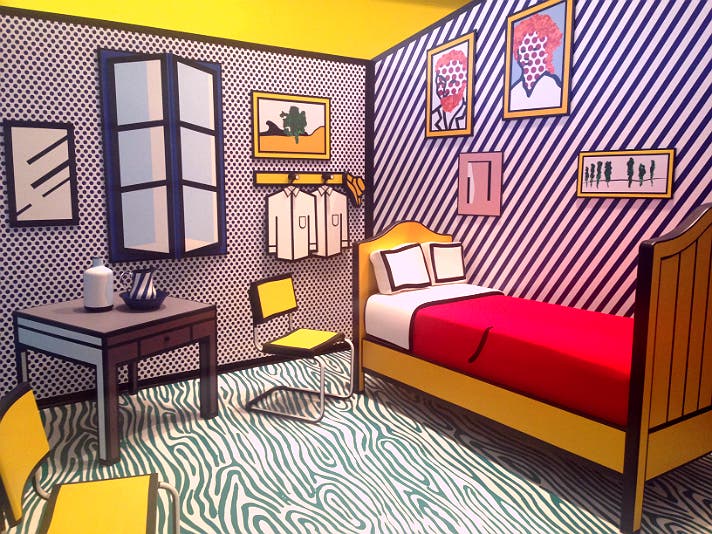
Roy Lichtenstein (1923–1997) was one of the most influential artists of the twentieth century. Renowned for his representations of everyday objects and his inventive interplay of line, dot, and color, Lichtenstein created cartoon-inspired paintings that helped launch the Pop Art movement.
Organized by the Skirball Cultural Center in Brentwood, Pop for the People: Roy Lichtenstein in L.A. explores how the artist and the movement—buoyed by a renaissance in printmaking in Los Angeles—made fine art accessible to the American public in ways that had not been achieved before. Pop for the People examines the historical and cultural context of Lichtenstein’s life and work, and also considers the social impact of Pop Art, especially as it developed in L.A.
Member Educational Seminar: India & China: Travel Profiles and Opportunities
Los Angeles Tourism & American Airlines Present: India & China: Travel Profiles and Opportunities:
When: Wednesday, June 6, from 9:30 - 11 a.m.
Where: Convene: 333 S Grand Avenue, 3rd Floor, Los Angeles, CA 90071
Agenda:
• 9:30am-10am: Registration & Networking
• 10am-10:30am: Kathy Smits, VP, Tourism - Los Angeles Tourism
• 10:30am-10:45am: Wendy Kheel, VP, Tourism Insights, Los Angeles Tourism
• 10:45am-11am: Kyle Mabry & Suzanne Boda, American Airlines
• 11am: Venue tours
Parking: Complimentary valet parking available. Please see attached instructions.
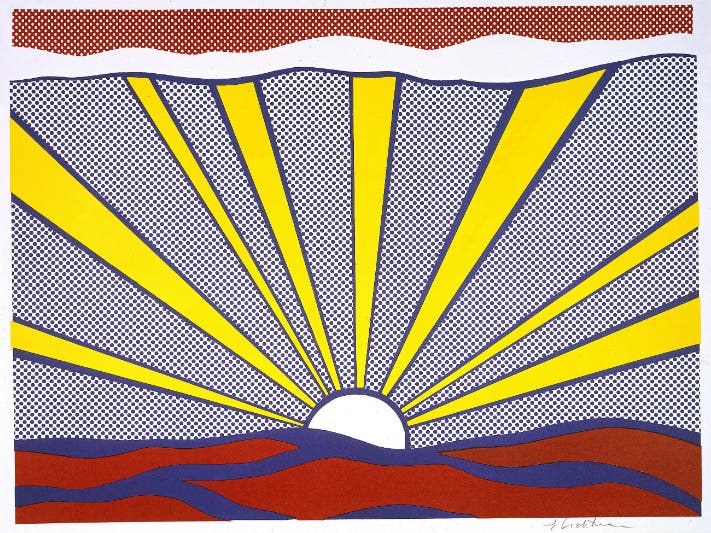
On view at the Skirball through March 12, 2017, Pop for the People displays more than 70 Lichtenstein works, spanning four decades. The exhibition includes the seminal Ten Dollar Bill (1956), one of Lichtenstein’s first Pop Art pieces; the iconic Sunrise (1965) and Shipboard Girl (1965), created when he was first gaining renown; and more than 20 prints created in collaboration with acclaimed L.A. printing house, Gemini G.E.L.
Read on for highlights of Pop for the People: Roy Lichtenstein in L.A. at the Skirball Cultural Center.
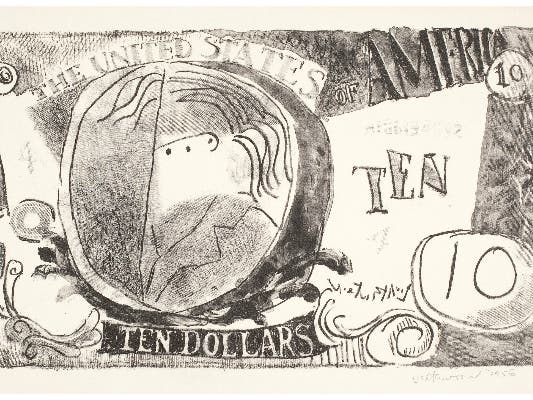
NO ROOM FOR ANOTHER ABSTRACT EXPRESSIONIST
Early in his career, Lichtenstein struggled to find a place among the ranks of the Abstract Expressionists, who dominated the American art landscape throughout the 1950s. On view at the Skirball, the rarely exhibited Ten Dollar Bill (1956) is regarded as one of Lichtenstein’s first Pop Art works. Along with Look Mickey (1961), which is in the collection of the National Gallery of Art in Washington, D.C., Ten Dollar Bill marks the defining moment when Lichtenstein transitioned to making art based on recognizable images from everyday American life.
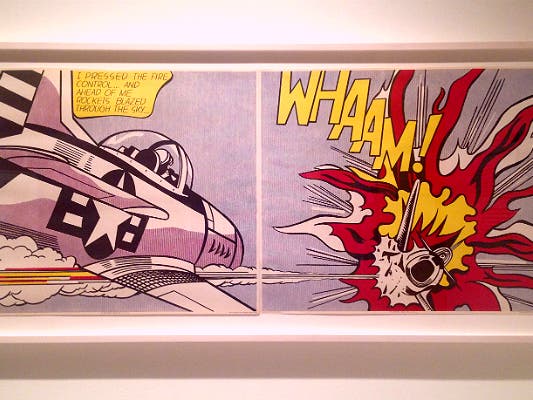
COMIC BOOKS
“All my art is in some way about other art, even if the other art is cartoons.” —Roy Lichtenstein
Lichtenstein reinvented borrowed imagery using a new graphic formula composed of Ben-Day dots, stylized painterly lines, and bold primary colors. He felt that comic books offered a way to connect people to one another through their shared human experiences: “Through my comic book works, I tried to build on emotions of various kinds whether it was love or war.”
Several of Lichtenstein’s famed comic works, such as the iconic Whaam! (1963) and As I Opened Fire (1964), are displayed alongside the actual comic books from which he appropriated. By drawing inspiration from comic books, advertising and children’s books, Lichtenstein elevated popular imagery to high art and invited viewers to recognize the world around them.
The origin for Lichtenstein's comic art can be traced to his service in World War II. At army boot camp, Lichtenstein met American Jewish officer and comic book illustrator, Irv Novick. After noticing Lichtenstein’s artistic talent, Novick had him design signs and posters for the army’s Stars and Stripes newspaper. Novick’s work would later serve as the direct inspiration for Whaam!.
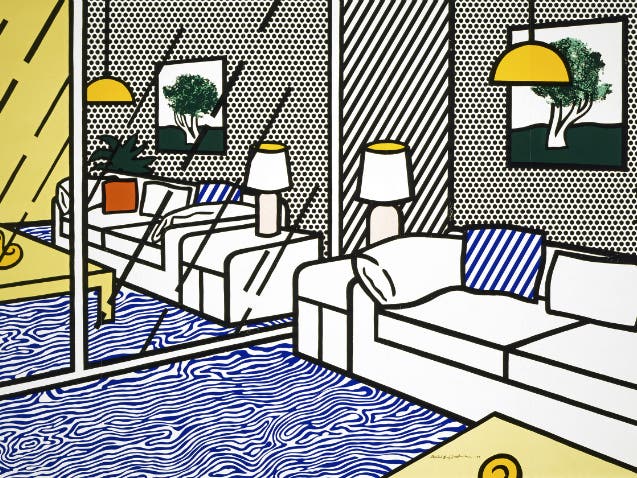
THE PRINT RENAISSANCE IN L.A.
In the early 1960s, fine art printmaking was on the verge of a technical and popular renaissance. The cutting edge of print experimentation shifted from France to America. The initial focus of this print revival was on lithography, primarily as a result of the training that master printers received at the Tamarind Lithography Workshop, established in Los Angeles in 1960.
Sidney Felsen and Stanley Grinstein ventured into fine art printing in 1966. Together with master printmaker Kenneth Tyler, they founded Gemini G.E.L., a groundbreaking printing house that was integral to the emergence of the Los Angeles art scene and helped transform the city into a global center for printmaking and Pop Art.
The long and fruitful collaboration between Lichtenstein and Gemini G.E.L. spanned more than 25 years. Lichtenstein and Gemini collaborated on 124 editions, which made Gemini and Los Angeles an important part of Lichtenstein’s work and social life. Pop for the People features more than 20 Lichtenstein prints that resulted from his creative partnership with Gemini. In addition to the Gemini prints on view, several rarely- or never-before-seen photographs show Lichtenstein at work in the Gemini studios and around L.A. with family, fellow artists, and his New York gallerist, Leo Castelli.
Felsen recalls Lichtenstein’s ritualistic work schedule during that period: “Roy would arrive at the workshop each morning at 9 o’clock, prepared and ready for work. He worked a full day, setting goals for himself daily. Lunch was from one to three in the afternoon; it always began with a margarita, no salt.”
With his Interior Series (1992), Lichtenstein and Gemini pushed beyond the existing limitations of scale and technique in printmaking. In order to accommodate these works, Gemini had to commission the expansion of its printing presses. The centerpiece of the exhibition's main gallery, Wallpaper with Blue Floor Interior (1992) is renowned as a major achievement in fine art printing. The five-panel, nine-color screenprint was created in 36 print runs.
Gemini’s mantra—“Here is a workshop, there are no rules, no restrictions, do what you want to do”—made it the venue of choice when the greatest artists in America wanted to make prints and multiples. In addition to Lichtenstein, Gemini published work by legendary postwar artists such as Robert Rauschenberg, Jasper Johns, Ellsworth Kelly, Claes Oldenburg, and Frank Stella, among others.
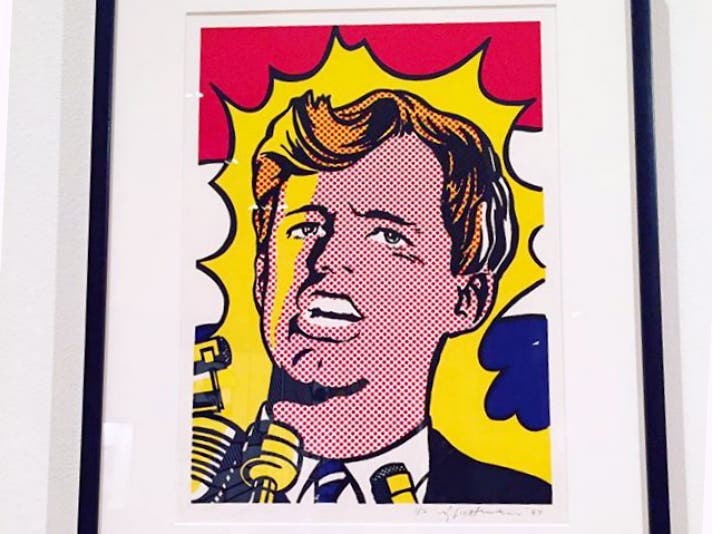
THE PEOPLE AND POLITICS
Pop for the People opened a month before Election Day. By the time the exhibit closes in March 2017, the country will have inaugurated a new president. Apropos to the contentious election year, the exhibition includes selections of Lichtenstein’s political art from the 1960s through the '80s. Two 1968 works, Bobby Kennedy and Gun in America, were Lichtenstein's responses to major national news. Commissioned by TIME magazine while Senator Robert F. Kennedy was on the presidential campaign trail, Lichtenstein's portrait was featured on the cover of the May 24, 1968 issue. Less than three weeks later, Kennedy was gunned down while campaigning in Los Angeles.
After Kennedy's assassination, TIME again commissioned Lichtenstein to create a cover. The provocative Gun in America was the cover of TIME magazine’s controversial June 21, 1968 issue. Lichtenstein depicted a gun—the same type used by Kennedy’s assassin—pointed directly at the viewer. It was a haunting commentary on the gun violence that had swept the nation, and helped to fuel a heated national debate about gun control that continues to this day. Displayed next to each other in the gallery, Bobby Kennedy and Gun in America still have a powerful impact decades after their publication.
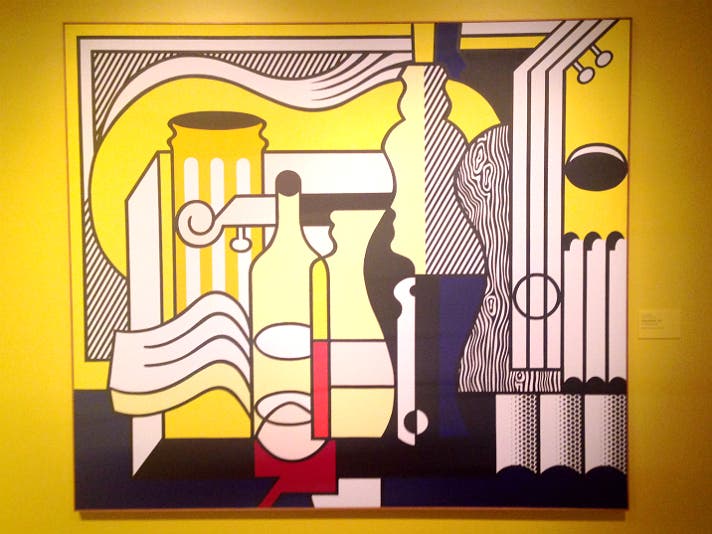
LICHTENSTEIN AND JAZZ
Lichtenstein felt a strong connection between jazz music and his art - jazz elements and instruments were incorporated into many of his paintings and prints. His wife, Dorothy, explains, “Roy wanted to take an idea and twist it. In jazz, you go away from the basic melody and you are riffing on it … so there’s an ironic playfulness at work, these are riffs on a theme. Roy was always very serious about his playfulness.” Lichtenstein often listened to the albums of Charlie Parker, Miles Davis, and John Coltrane in his art studio. He even began taking saxophone lessons at the age of 70 with renowned jazz saxophonist, Hayes Greenfield.
The soundtrack playing in the gallery is The Epic, the critically acclaimed debut solo album by Kamasi Washington. Born and raised in Los Angeles, Washington is a saxophonist and composer who has played on Kendrick Lamar’s To Pimp a Butterfly, as well as tracks by Flying Lotus and Thundercat. Weaving in elements of hip-hop and electronica, Washington's music mirrors Lichtenstein’s art in the way he looks to jazz greats of the past—Coltrane, Davis, Weather Report—for inspiration in order to reimagine their work.

LICHTENSTEIN ON DALÍ, MONET, PICASSO & VAN GOGH
Whether the artist was Salvador Dalí, Claude Monet, Pablo Picasso or Vincent Van Gogh, Lichtenstein referenced other artists and schools in his work throughout his career. In reinventing the work of modern masters, Lichtenstein addressed his generation’s definition of fine art, blurring the lines between high and low, original and reproduction.
As part of Pop for the People, a second gallery displays Lichtenstein’s collaborations with Gemini G.E.L.—including Haystack (1969), Bull Profile (1973), and Surrealist (1977) series—in which he reconsiders the work of Monet, Picasso, and Dalí, respectively.
Bedroom at Arles
The highlight of the second gallery is the Skirball's life-size buildout of Lichtenstein’s 1992 painting, Bedroom at Arles, based on a series of the same name by Vincent van Gogh. Ready-made for social media, the stunning installation invites visitors to not just look at the art, but to inhabit it, celebrating the “what’s mine is yours” ethos of the Pop Art movement.
In Lichtenstein’s painting, most of the objects, including the bed and chairs, are positioned similarly to Van Gogh’s The Bedroom (1889). The room has a window, blue walls, and a yellow bed with a red blanket, but Lichtenstein has recreated the scene in his comic book-influenced style. The furniture and objects in the room are modern counterparts of those depicted in the Van Gogh painting.
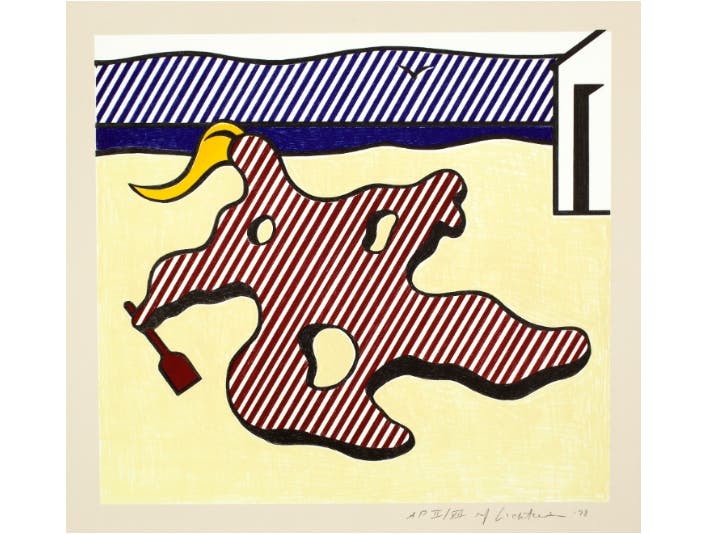
Lichtenstein and Dalí
In 1977, Lichtenstein, in collaboration with Gemini G.E.L., turned his attention to Salvador Dalí with his Surrealist Series. Lichtenstein satirized Surrealism and made the once-radical art movement less cryptic and more approachable. The works from Lichtenstein’s Surrealist Series simplify Dalí’s dreamlike landscapes. Lichtenstein’s Nude on Beach (1978) is a humorous reinterpretation of Dalí’s The Persistence of Memory (1931).
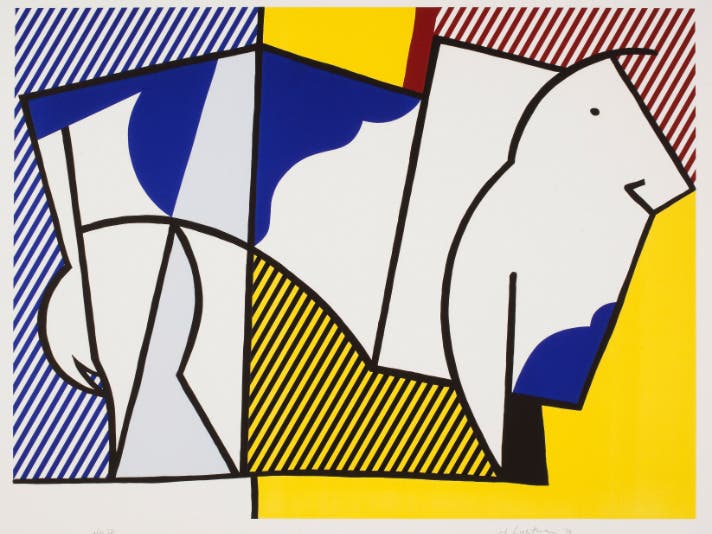
Lichtenstein and Picasso
Lichtenstein’s Bull Profile Series (1973) directly quotes Pablo Picasso’s lithographic series The Bull (Le Taureau) (1946), as well as the Dutch artist Theo van Doesburg’s 1916–17 studies, in which a cow was drawn in incrementally more and more abstract ways. To bring his interpretation of the earlier works to life, Lichtenstein collaborated with Gemini G.E.L. and created a progression of six prints that simplify and abstract a Holstein cow.
Picasso was Lichtenstein’s childhood hero. As Lichtenstein explained, “I think Picasso is the best artist of this century, but it is interesting to do an oversimplified Picasso—to misconstrue meaning of the shapes and still produce art.”
